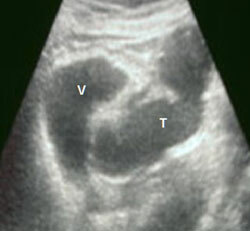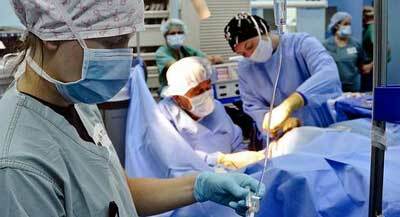Spikes in the fallopian tubes can be a serious obstacle to the onset of pregnancy. They are a consequence of the inflammatory process, localized in the small pelvis and are seals from the connective tissue.
The finest fibers of the fabric are fused together and extend from one organ to the other. Spikes can completely block the lumen of the fallopian tubes and spread beyond them.
If obstruction is observed in both tubes, then the woman can become pregnant only with the help of IVF or ICSI, if the results of spermogram presuppose exactly this way of fertilization of the oocytes.
Contents
- 1 Reasons for the appearance of adhesions
- 1 Reasons for the appearance of adhesions
- 2 Signs of the presence of adhesions in the fallopian tubes
- 3 Diagnosis of the disease
- 4 Treatment of adhesions in the fallopian tubes
- 5 Adhesions and pregnancy
- 6 Classification of the disease according to the ICD
- 7 Prevention
Reasons for the appearance of adhesions
Inflammation is the main cause of connective tissue tightening and adhesion formationthe doctor needs to find out what it was provoked.
This can include both natural factors and mechanical damage resulting from surgical interventions.
There are several causes of adhesions in the fallopian tubes:
- Abortions, diagnostic curettage.
These surgical procedures involve the separation of the endometrium layer from the inside of the uterine wall.
As a result of scraping, a wide wound surface is formed, and its healing is sometimes accompanied by inflammatory processes that can later spread to the fallopian tubes.
- Surgical interventions in the abdominal cavity.
Wound healing after surgery can also be accompanied by an inflammatory process. Especially it concerns those cases when surgical intervention has been made repeatedly, after poorly executed first operation.
- Intrauterine device.
The method of contraception is that a device made of plastic and copper is implanted in one of the walls of the uterus. The site of spiral implantation can inflame, this inflammation has a chance to spread beyond the uterus and affect the fallopian tubes.
- Inflammation of appendages( adnexitis).
It occurs as a result of hypothermia or general weakening of the body against the background of ARVI or influenza.
- Some diseases
Diseases transmitted sexually - chlamydia, ureaplasmosis, gonorrhea. All of them cause the presence of a slow inflammatory process in the small pelvis.
Signs of the presence of adhesions in the fallopian tubes
In some women, adhesive formations do not have pronounced symptoms. Sometimes the problem is found after several years of fruitless attempts to conceive a child or after an ectopic pregnancy.
However, in some cases, the symptoms of the presence of adhesions in the fallopian tubes are quite clear:
- The presence of fluid in the posteroluminal space according to the results of ultrasound.
- Periodic pain in the lower abdomen.
- Minor increase in temperature, accompanied by pain in the abdominal cavity( in acute form).
Diagnosis of the disease
Since adhesions lead to obstruction of the fallopian tubes, it is necessary to diagnose them at the very beginning of the formation. Suspicion of the presence of seals of connective tissue in the small pelvis may occur in the doctor when comparing several results of ultrasound of the uterus and appendages performed within six months.
In conclusion, an expert in ultrasound diagnostics will note the presence of fluid in the anterior space. Normally, this phenomenon can be observed only in the first two days after ovulation.
But if the doctor on ultrasound diagnoses it on different days and different phases of the cycle, this indicates an inflammatory process in the pelvic organs.
Therefore, it is necessary to check the patency of the fallopian tubes, especially if the woman is planning a pregnancy.
Sonosalpingoscopy( SSS) - the procedure is performed in the first phase of the menstrual cycle, approximately 6-8 days. Before the study, anesthesia is done with rectal suppositories or injections.
The uterus is filled with a special liquid through the catheter, which must pass into the tubes, and then flow into the abdominal cavity. The session lasts about half an hour, and all manipulations and fluid advancement are monitored by ultrasound.
Hysterosalpingography( GHA) - the procedure is carried out in the second phase of the cycle. Immediately before going to the hospital you need to do a cleansing enema. The physician portionwise introduces a special solution through a catheter that fills the uterus and fallopian tubes.
The control of the progress of the liquid is carried out using an X-ray. In addition, compared with the SSA in the GHA, a more viscous contrast substance is used, so hysterosalpingography can be more painful.
Treatment of adhesions in the fallopian tubes
 Since the adhesion process in many cases is asymptomatic, it is found already in the advanced stage, when the elimination of seals of connective tissue will be long and, possibly, expensive.
Since the adhesion process in many cases is asymptomatic, it is found already in the advanced stage, when the elimination of seals of connective tissue will be long and, possibly, expensive.
Treatment of adhesions in the fallopian tubes involves a combination of medication, physiotherapy and surgery. If the disease has taken an acute form, the doctor will prescribe observation in the hospital.
Medical treatment
Drugs and injections are indicated when the inflammatory process has caused urogenital infections or hormonal failures. Therefore, drug therapy can be aimed at eliminating the infection or at leveling the hormonal background.
Antibacterial treatment - is performed when the results of the analysis showed the presence of STDs( chlamydia, cytomegalovirus, ureaplasma, etc.). Antibiotics such as Amoxiclav, Ampiox, Cephalexin are used.
Hormonal treatment - is performed when the results of the examination revealed the presence of endometriosis. The doctor will prescribe the necessary drugs, based on what the analysis shows for hormones.
Physiotherapy
Electrophoresis - activates blood circulation in the small pelvis, is performed with adhesions to group B vitamins. In this case, the effect of the current is directed to the pituitary gland, so that it begins to produce a sufficient amount of hormones.
Then, after finishing this course of treatment, the doctor directs the effect of the current directly to the abdominal region and electrophoresis is done already with the participation of zinc or lidase.
Hirudotherapy - treatment with leeches. Together with drug therapy it gives a positive effect and helps to resolve even a large number of adhesions.
The leech saliva destroys the scars formed as a result of the adhesive process, makes the seals themselves elastic and mobile.
Surgical treatment
Conservative treatment for tube obstruction not always helps. Therefore, in order for a woman to have a chance to become pregnant on her own, the doctor prescribes laparoscopy of the fallopian tubes.
This surgical intervention is considered to be the most effective in combating the elimination of the effects of the inflammatory process, but it is prescribed only when other methods did not bring the desired results.
Laparoscopy is tolerated by patients much more easily than a full-blown abdominal surgery, and doctors themselves prefer this method of removing adhesions in the fallopian tubes for several reasons:
- A small amount of stitches;
- Rapid healing of puncture sites;
- Gentle for the abdominal organs of the nature of the intervention;
- Highly informative.
In the operation, three punctures are made, then through them with a video camera and surgical instruments the doctor clears the fallopian tube cavity and the area around them from adhesions( or an ectopic pregnancy, if any) and then stitches.

If the tubes are not completely filled with adhesions, then the efficacy of laparoscopy is 65-70% and after the restoration of the fertility of the organ the pregnancy can occur in 3-4 months.
Adhesions and pregnancy
In most cases, the adhesion process in the fallopian tubes interferes with the conception of the child, or creates a dangerous situation in which pregnancy becomes ectopic. Usually, fertilization occurs in the tubes, and then the fetal egg descends into the uterus and is implanted into one of its walls.
In the presence of adhesions, a fertilized egg can not move downward, so it must be implanted directly into the wall of the fallopian tube.
If the operation is not performed on time, then this organ ruptures because of a growing embryo and a woman can die - if an emergency intervention by medics does not prevent the development of peritonitis and sepsis.
If the obstruction of the pipes is complete, the doctors recommend that they abandon their independent attempts to become pregnant and begin preparing for an IVF procedure.
Classification of the disease according to the ICD
ICD is an international classification of diseases, which is reviewed every 10 years under the supervision and guidance of WHO.Currently, ICD 10 revision is valid, which presupposes the presence of subsection "Salpingitis and oophoritis", which has code N70.
The acute form of the disease has the code value N70.0;chronic - N70.1;unspecified - N70.9.
It should be noted that the ICD only provides statistical data on the diseases, but does not set itself the task of developing a specific instruction for treatment of the disease.
Prevention
Spikes in pipes are easier to prevent than to fight them later. Therefore, preventive measures include the following:
- Avoid supercooling of the pelvic organs.
- In time begin treatment of any kind of urogenital infections.
- Monitoring the state of the surgical site in the abdominal cavity.
- Correct hormonal disorders.
Since fallopian tubes play an important role in the conception of a child, it is necessary to treat their health with utmost care. And if obstruction of the fallopian tubes due to adhesions is already available, then pregnancy planning should be started only after treatment courses and with the approval of a doctor.



